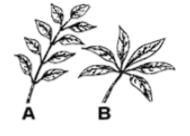Test: Morphology of Flowering Plants - 1 - NEET MCQ
15 Questions MCQ Test Biology Class 11 - Test: Morphology of Flowering Plants - 1
The small lateral outgrowth of the leaf base which protect the young leaf and its axillary buds in young stage is called
The science that deals with the study of form, size, colour, structure and relative position of various parts of organism is called
In which type of placentation, the ovary is unilocularwith a single ovule?
Inflorescence which shows indefinite growth and bears a number of flowers due to active growing point is called
The Aleurone layer of Maize grain is especially rich in
A scar on the seed coat through which the developing seeds were attached to the fruit is called
If the margin of thalamus grows upward enclosing the ovary completely and getting fused with it, the other parts of flower arise above the ovary, the flower is said to be
Pulses which we use for daily purpose belong to the family
The cells proximal to the merismatic zone in root tip represents
Drupes are also called as stone fruits because
Reason: Bracts are modified leaves found at the base of the pedicel in some flowers.
|
169 videos|531 docs|136 tests
|




















